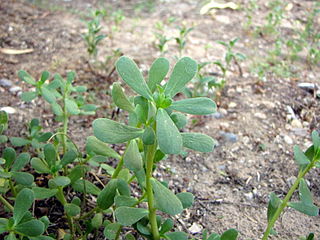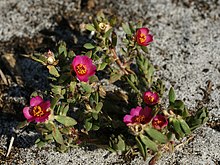
Portulaca oleracea is an annual succulent in the family Portulacaceae.

Portulaca is the type genus of the flowering plant family Portulacaceae, with over 100 species, found in the tropics and warm temperate regions. They are known as the purslanes.

The Portulacaceae are a family of flowering plants, comprising 115 species in a single genus Portulaca. Formerly some 20 genera with about 500 species, were placed there, but it is now restricted to encompass only one genus, the other genera being placed elsewhere. The family has been recognised by most taxonomists, and is also known as the purslane family. It has a cosmopolitan distribution, with the highest diversity in semiarid regions of the Southern Hemisphere in Africa, Australia, and South America, but with a few species also extending north into Arctic regions. The family is very similar to the Caryophyllaceae, differing in the calyx, which has only two sepals.

Stevia rebaudiana is a plant species in the genus Stevia of the family Asteraceae. It is commonly known as candyleaf, sweetleaf or sugarleaf.

Talinum fruticosum is a herbaceous perennial plant that is native to Mexico, the Caribbean, West Africa, Central America, and much of South America. Common names include Ceylon spinach, waterleaf, cariru, Gbure, Surinam purslane, Philippine spinach, Florida spinach, potherb fameflower, Lagos bologi, sweetheart, and Kutu bataw in Ghana from the Akan language It is widely grown in tropical regions as a leaf vegetable.

Calandrinia is a large genus of flowering plants known as purslanes and redmaids. It includes over 100 species of annual and perennial herbs which bear colorful flowers in shades of red to purple and white. Plants of this genus are native to Australia, western South America, Central America, and western North America. Some species have been introduced to parts of New Zealand, southern Africa, Asia, and Europe.

Portulaca grandiflora is a succulent flowering plant in the family Portulacaceae, native to southern Brazil, Argentina, and Uruguay and often cultivated in gardens. It has many common names, including rose moss, eleven o'clock, Mexican rose, moss rose, sun rose, rock rose, and moss-rose purslane.

Talinum paniculatum is a succulent subshrub in the family Talinaceae that is native to much of North and South America, and the Caribbean countries. It is commonly known as fameflower, Jewels-of-Opar, or pink baby's-breath.
Lepidagathis alopecuroidea, synonym Teliostachya alopecuroidea, the pata de gallina, is a plant with a wide distribution in the Americas and Africa.

Zephyranthes candida, with common names that include autumn zephyrlily, white windflower, white rain lily, and Peruvian swamp lily, is a species of rain lily native to South America including Argentina, Uruguay, Paraguay, and Brazil. The species is widely cultivated as an ornamental and reportedly naturalized in many places.

Portulaca sedifolia is a species of flowering plant in the purslane family, Portulacaceae, that is endemic to Yemen. Its natural habitat is rocky areas.

Sesuvium portulacastrum is a sprawling perennial herb in the family Aizoaceae that grows in coastal and mangrove areas throughout much of the world. It grows in sandy clay, coastal limestone and sandstone, tidal flats and salt marshes, throughout much of the world. It is native to Africa, Asia, Australia, Hawai`i, North America and South America, and has naturalised in many places where it is not indigenous.

Ulmus parvifolia, commonly known as the Chinese elm or lacebark elm, is a species native to eastern Asia, including China, India, Japan, Korea, and Vietnam. It has been described as "one of the most splendid elms, having the poise of a graceful Nothofagus".

Ludwigia palustris is a species of flowering plant in the evening primrose family known by the common names marsh seedbox, Hampshire-purslane and water purslane. This is an aquatic or semiaquatic perennial herb which grows in moist to wet to flooded areas. It is sometimes a weed. The species epithet palustris is Latin for "of the marsh" and indicates its common habitat.

Portulaca pilosa is a species of flowering succulent plant in the purslane family, Portulacaceae, that is native to the Americas. Its common names include pink purslane, kiss-me-quick and hairy pigweed. Its range extends from the southern United States and the Caribbean as far south as Brazil. It is a succulent with linear leaves and pink flowers.

Portulaca suffrutescens, the shrubby purslane, is a plant species native to the southwestern United States and northern and central Mexico. It has been found in Arizona, New Mexico, Texas, Sonora, Chihuahua, Sinaloa, Durango, Querétaro and Guerrero.

Portulaca oleracea subsp. sativa also known as golden purslane is one of few subspecies of Portulaca oleracea.

Portulaca umbraticola, also known as the wingpod purslane, is an annual or short-lived perennial succulent in the genus of flowering plants Portulaca.

Portulaca quadrifida, known as pusley, wild purslane, chicken weed, single‑flowered purslane, small‑leaved purslane and 10 o'clock plant, is a species of flowering plant in the genus Portulaca, possibly native to Africa, but certainly widespread over the Old World Tropics, and introduced elsewhere. It is collected in the wild and eaten in salads or cooked, and is a favorite fodder for chickens and pigs.

















